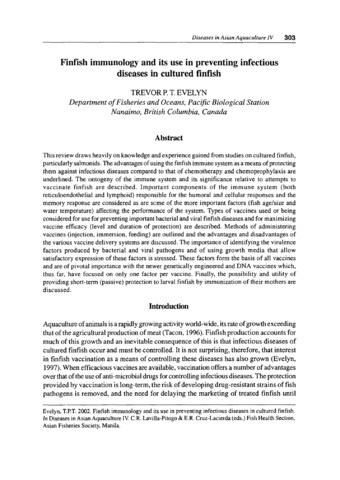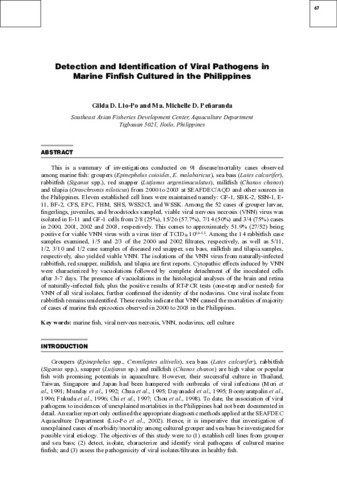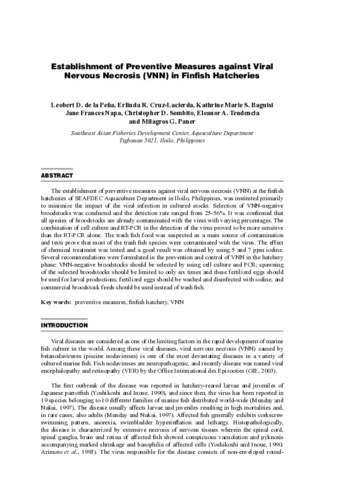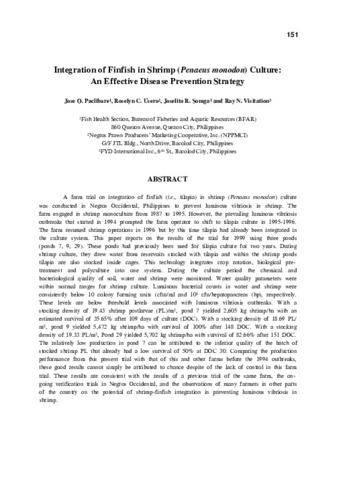Finfish immunology and its use in preventing infectious diseases in cultured finfish
- Global styles
- MLA
- Vancouver
- Elsevier - Harvard
- APA
- Help

View/
Date
2002Author
Page views
993ASFA keyword
AGROVOC keyword
Metadata
Show full item record
Share
Abstract
This review draws heavily on knowledge and experience gained from studies on cultured finfish, particularly salmonids. The advantages of using the finfish immune system as a means of protecting them against infectious diseases compared to that of chemotherapy and chemoprophylaxis are underlined. The ontogeny of the immune system and its significance relative to attempts to vaccinate finfish are described. Important components of the immune system (both reticuloendothelial and lymphoid) responsible for the humoral and cellular responses and the memory response are considered as are some of the more important factors (fish age/size and water temperature) affecting the performance of the system. Types of vaccines used or being considered for use for preventing important bacterial and viral finfish diseases and for maximizing vaccine efficacy (level and duration of protection) are described. Methods of administering vaccines (injection, immersion, feeding) are outlined and the advantages and disadvantages of the various vaccine delivery systems are discussed. The importance of identifying the virulence factors produced by bacterial and viral pathogens and of using growth media that allow satisfactory expression of these factors is stressed. These factors form the basis of all vaccines and are of pivotal importance with the newer genetically engineered and DNA vaccines which, thus far, have focused on only one factor per vaccine. Finally, the possibility and utility of providing short-term (passive) protection to larval finfish by immunization of their mothers are discussed.
Suggested Citation
Evelyn, T. P. T. (2002). Finfish immunology and its use in preventing infectious diseases in cultured finfish. In C. R. Lavilla-Pitogo & E. R. Cruz-Lacierda (Eds.), Diseases in Asian aquaculture IV: Proceedings of the Fourth Symposium on Diseases in Asian Aquaculture, 22-26 November 1999, Cebu City, Philippines (pp. 303-324). Fish Health Section, Asian Fisheries Society.
Type
Conference paperISBN
9718020160Collections
Related items
Showing items related by title, author, creator and subject.
-
Detection and identification of viral pathogens in marine finfish cultured in the Philippines
Lio-Po, Gilda D.; Peñaranda, Ma. Michelle D. (Aquaculture Department, Southeast Asian Fisheries Development Center, 2005-03)This is a summary of investigations conducted on 91 disease/mortality cases observed among marine fish: groupers (Epinephelus coioides, E. malabaricus), sea bass (Lates calcarifer), rabbitfish (Siganus spp.), red snapper ... -
Establishment of preventive measures against viral nervous necrosis (VNN) in finfish hatcheries
de la Peña, Leobert D.; Cruz-Lacierda, Erlinda R.; Baguisi, Kathrine Marie S.; Napa, Jane Frances; Sombito, Christopher D.; Tendencia, Eleonor ; Paner, Milagros G. (Aquaculture Department, Southeast Asian Fisheries Development Center, 2005-03)
The establishment of preventive measures against viral nervous necrosis (VNN) at the finfish hatcheries of SEAFDEC Aquaculture Department in Iloilo, Philippines, was instituted primarily to minimize the impact of the viral ...
; Paner, Milagros G. (Aquaculture Department, Southeast Asian Fisheries Development Center, 2005-03)
The establishment of preventive measures against viral nervous necrosis (VNN) at the finfish hatcheries of SEAFDEC Aquaculture Department in Iloilo, Philippines, was instituted primarily to minimize the impact of the viral ... -
Integration of finfish in shrimp (Penaeus monodon) culture: an effective disease prevention strategy
Paclibare, Jose O.; Usero, Roselyn C.; Somga, Joselito R.; Visitacion, Ray N. (Aquaculture Department, Southeast Asian Fisheries Development Center, 2002)A farm trial on integration of finfish (i.e., tilapia) in shrimp (Penaeus monodon) culture was conducted in Negros Occidental, Philippines to prevent luminous vibriosis in shrimp. The farm engaged in shrimp monoculture ...




